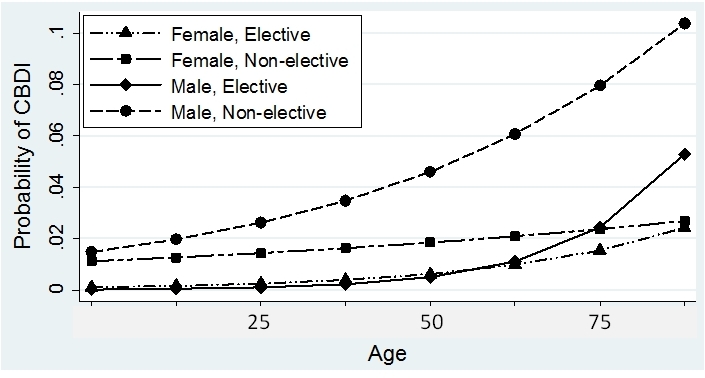|
Back to Annual Meeting Program
Predictors of Bile Duct Injury During Laparoscopic Cholecystectomy: Experience From Two Hospitals
Curtis J. Wray*1, John a. Harvin1, Uma R. Phatak1, Lillian S. Kao1, Tien C. Ko1, Taylor S. Riall2
1Surgery, University of Texas Medical School at Houston, Houston, TX; 2Surgery, University of Texas Medical Branch, Galveston, TX
Introduction: Bile duct injuries (BDI) during laparoscopic cholecystectomy (LC) are a devastating complication. Due to the infrequent occurrence of BDIs, predictive factors are not well-understood. We hypothesized increased age is a risk factor for BDI.
Methods: IRB-approved review of LC at two safety-net hospitals from 2005-2011. LC cases were coded elective (same day surgery) or non-elective (admitted through emergency room). Morbidity/mortality conferences, hospital records and prospective data were used to identify BDIs. The Strasberg classification was used to define BDI. We created a multivariate regression model to identify predictors of BDI.
Results: 2896 LCs (n=2370 female n=526 male) were performed at two hospitals. 52% of cases were elective. 120 cases were converted to an open operation. Males had a higher mean age (years) than females (47 ±15 vs 39 ±14, p=0.01). 40 BDIs were identified. The most common BDI was type A (N=27, women=14 vs men=13), followed by E3 (N=4), D (N=4), E2 (N=3) and C (N=2). Predictors of BDI included: Age (OR 1.44, 95%-CI 1.10-1.89), male gender (OR 3.07 95%-CI 1.83-5.12) and non-elective operation (OR 5.11 95%-CI 1.16-22.5). The predicted probability of BDI increased with advancing ages, but more so for men who underwent non-elective LCs (see graph).
Conclusions: The risk of major or minor BDIs is significant in older males undergoing non-elective LCs. Increased risk of BDIs, due to increase age and emergency surgery, should be risk factors considered when discussing the need and timing of elective LC, especially with male patients. Earlier referral and interventions aimed at decreasing the percentage of emergency LCs may decrease the incidence of BDIs.

Back to Annual Meeting Program
|


